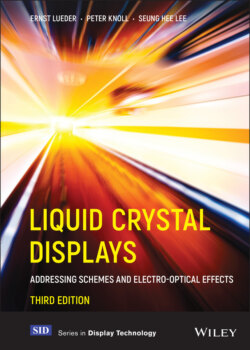Читать книгу Liquid Crystal Displays - Ernst Lueder - Страница 35
4.2 The Various Types of TN Cells 4.2.1 The regular TN cell
ОглавлениеThis cell is the most widely used active matrix LCD(Schadt and Helfrich, 1971; Yeh, 1988), and represents a special case of the general result in Equation (4.51). The linearly polarized light is incident at an angle
(4.53)
in Figure 4.1 that is parallel to the director of the LC molecules on top of the orientation layer. The twist angle is
leading to a pitch in Equation (4.49) of p = 4d. Hence, at z = d the helix has reached a quarter of a turn. From these values follow a in Equation (4.48) as
and γ in Equation (4.47) as
In Equation (4.51), the σ-axis is rotated by β = π/2 from the x-axis, whereas the τ-axis is parallel to the x-axis. The Jones vectors in the σ-τ axes assume, after insertion of Equations (4.54), (4.55) and (4.56) into Equation (4.51), the form
and
(4.58)
For parallel polarizers the analyser lies in the τ-axis. The intensity Iτ passing this analyser is (Gooch and Tarry, 1974)
The reduced transmission is plotted in Figure 4.3 versus a = 2dΔn/λ. Zeros occur for and hence for . In the first minimum we obtain, with from Equation (4.55), the optical retardation
(4.60)
and the thickness d for a given λ = λ0 as
The d value is larger by a factor than the corresponding one for the Fréederickzs or the DAP cell in Equation (3.80). The thicker cell can be manufactured with a larger yield, as the risk of generating shorts by dust particles in the cell is reduced. Obviously, the effective retardation in a twisted cell is smaller than in an untwisted one, resulting in a larger thickness. A similar effect is already known from the HAN cell.
According to Equation (4.61), the blocking of light with λ0 = 550 nm requires with Δn = 0 15 a thickness d = 3.1 μ when working at the first minimum.
Figure 4.3 The intensity of light passing through a non-addressed TN-LCD with twist angle β = π/2 with a = 2dΔn/λ according to Equation (4.59)
Extinction of the light in Figure 4.3 occurs only for one wavelength λ. Neighbouring wavelengths can pass, which light up the black state with a bluish-yellowish tint. Hence, this normally black mode provides a poor black state. It will be enhanced by compensation foils introduced in Chapter 6.
In the addressed state with the maximum voltage around 6V all LC molecules have aligned for Δε > 0 in parallel to the electric field. The incoming linearly polarized light experiences no birefringence and arrives unchanged at the parallel analyser, which can be passed. The transmission T of light for this normally black cell is depicted versus the reduced voltage across the cell in Figure 2.13.
In the operation with crossed polarizers leading to the normally white mode, the analyser lies in the σ-direction in Figure 4.1. The pertinent Jones vector Osσ for the field-free state is given in Equation (4.57), from which the intensity Iσ passing the analyser follows as
(4.62)
with γ in Equation (4.56). This leads to
with a in Equation (4.55).
This reduced intensity is plotted versus a in Figure 4.4. The values are considerably larger than in the normally black mode in Figure 4.3. If the cell is fully addressed, the LC molecules orient themselves parallel to the field, and hence the incoming light, linearly polarized along the x-axis, reaches the crossed analyser unchanged, and is hence blocked independent of the wavelength. This generates an excellent black state if a field is applied. Therefore, the normally white cell is the preferred LCD.
The black state is independent of the thickness d. In the white state in Equation (4.63) and in Figure 4.4, the first maximum of the intensity lies in the vicinity of the first maximum of the cos term occurring at , and hence , leading again with a in Equation (4.55) to , as for the normally black mode. Further maxima occur around or as for the minima in the normally black mode. The maxima are of equal height l/2.
Figure 4.4 The intensity of light passing through a non-addressed normally white TN-LCD with twist angle β = π/2 and with a = 2dΔn/λ according to Equation (4.63)
